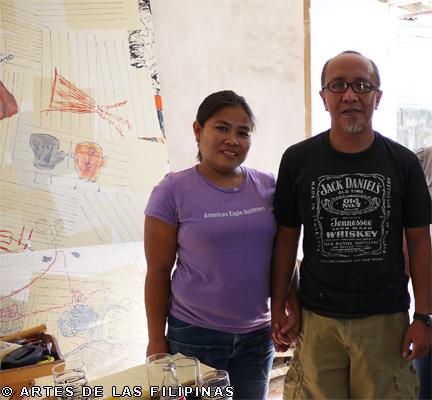
Cris Villanueva and his wife, Jenny
CRIS VILLANUEVA JR.’S BUBBLE WRAP ART
by: Christiane L. de la Paz
March 2010 -- Considered as one the most hardworking and innovative artists of today, Cris Villanueva Jr.’s works draw ideas from commonplace objects, classical and popular culture, literature, art, history and his own life. He disregards the non-objective representation of subjects but concentrates instead in creating works of iconic power. In the early stage of his artistic career, he began to introduce a signature style of painting bubble wrap over his finished painting as a layer effect. Cris Villanueva also goes beyond the limits of paintings and can paint “any style and subject I find challenging and interesting.” While his works in the last five years are less serious in tone, many of his exhibited works and those found in private collections reveal his knowledge of art theory and his talent in painterly details. In this interview, Cris Villanueva tells his stint as an art director, his student years as a Political Science major at the Philippine Christian University then as a Fine Arts student at the University of the Philippines, his early years as a member of the Salingpusa and the Madruguada, the two winning works he received from the Philip Morris Art Competition and how these two works have pushed him to go on.
What was your career path after graduating from the UP Fine Arts in 1990?
I was working as an art director in an advertising agency and I formed a group called Madruguada who are composed of art directors, copywriters, creative directors and other advertising agency artists and friends. I painted during the weekends and I get to exhibit with the group once a year.
What does your job entail as an art director?
I work with writers and creative directors in making TV commercials, newspaper ads and below the line materials for products and services. I also supervise a team of artists.
Was Fine Arts your first course in college?
No. I finished my Bachelor of Arts degree in Political Science at the Philippine Christian University in 1984 then I graduated in UP Fine Arts with a major in Visual Communications in 1990. Political Science was a Pre-Law course and at that time, I was interested in International Law and was planning to work with the Foreign Service.

Covers: Burn Them All (2004)
What made you decide to pursue a course in fine arts?
I always wanted to paint but I didn’t want a degree in fine arts. But while I was enrolled in the U.P. Graduate School of Political Science, I befriended many artists in UP and I found myself enrolling in Fine Arts a year later. I majored in Advertising because I wanted to help sell products and to have a regular day job.
Whose style are you drawn to painting during your student years?
I never really tried to have a specific style that is distinct from other artists but I observed the works of Roberto Chabet.
Who are your contemporaries in UP?
Elmer Borlongan, Ferdinand Montemayor and other members of our group in Salingpusa. Manuel Ocampo was a classmate.
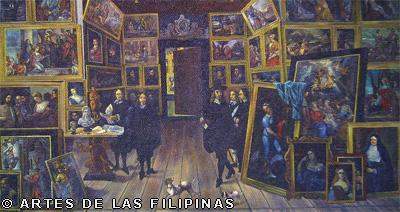
Reality Show: After David Teniers (2005)
Who are some of the UP professors who made a good impression on you?
Roberto Chabet. He was my professor in painting as I cross-enrolled in the Studio Arts Department while finishing my advertising course.
What are some of the lessons you’ve learned on your own that was not taught in school?
That by hanging around with artists could help in my studying painting and that there was no need for a degree in Painting.
After graduating, what was the first job you applied for?
I worked as an artist for Alpha records then for Yabut Advertising. I designed the record album covers of international musicians whose music were repackaged by Alpha as primers with partners abroad who were the record labels of these artists. In Yabut advertising, I first worked there as an OJT trainee and was hired later. I only stayed there for eight months. I worked for Yabut and Associates for three years as a visualizer, doing the layouts for advertisements and brochures, posters and other paraphernalia.
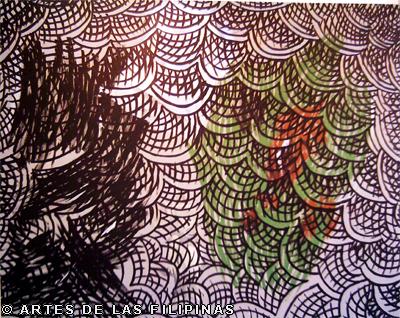
The Best Thing That Ever Happened With My Clothes On (2006)
After this stint, did you have another job?
Yes. I was taken by Avellana. I was a senior visualizer at Avellana and then my last job was as an art director for Image Dimension. I was the art director for Japanese accounts like Toyota, Ajinomoto, Seven Stars and many more. My advertising stint lasted for fifteen years because I was given an early retirement.I thought it was time for me to pursue a full-time career in painting.
You have been in the advertising industry for fifteen years, how did your experience and exposure in advertising help you in your profession as an artist?
Knowing the multimedia well helped me in conceptualizing my own works.
Are there other past experiences in your life that continue to help you?
Long distance cycling, reading and watching movies.

Paint It Black (2006)
When you entered the art scene in 1985, what is the status of the art scene at this time?
In 1985, Salingpusa had its first group show and I was part of the group. We were all students and struggling artists then. It was difficult but we started joining competitions and my companions, majority of them are the Salingpusa members, started dominating the art scene by winning awards.
From your own recollection, how did the group Salingpusa form?
UP Fine Arts students grouping together for discussions and eventually preparing for group shows with artists mostly from Antipolo but there were a few like Borlongan, Justiniani, Karen Flores and myself who were residents outside of Antipolo. The senior students were Rolly Acuna, Tony Leano and Andy Orencio. They were the first to have thought of the idea of forming a group together with Ferdinand Montemayor.
What do you think are the advantages and disadvantages of being part of an artist’s group?
As Fine Arts students, we had to form an artist’s group since we knew it was going to be a force that people had to reckon with. Being in a group entails a productive relationship with other members and constant discussions with them. But of course, a group always had problems both organizational and personal. Later on, we had to deal with each other’s egos.

Behind The Scene-Above The Frame (2007)
Tell me about the first painting that you sold.
I was in third year high school when I sold my first painting. The lady who bought my work didn’t pay me for it partly because I never followed up on the payment.
When did you have your first exhibit?
My first exhibit was in 1975 with Dean Jose Joya’s workshop in UP Iloilo with other Ilonggo artists in the workshop.
Do you agree that the first exhibit of a painter can make or break his career? Did this apply to you?
No. I had my first solo exhibit in Oar House in Malate and the place was a gathering point for photo journalists, CCP Theater people and the likes. I just had to show my works.
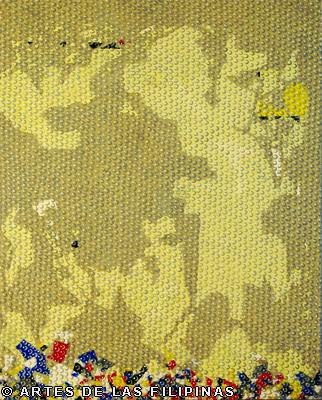
There Have Been Many Like It Before; After It There Will Be Many More (2007)
What was the first gallery that carried your works?
Pinto Gallery.
Must the artists be a resident of Antipolo to exhibit in Pinto?
No. I transferred in Antipolo only fifteen years ago.
These days, how do you choose which gallery to exhibit?
I can exhibit wherever I want. I started with Pinto only because of its space and proximity to my house. I also exhibit in other galleries like Boston, Magnet, West, Mo and Manila Contemporary. I chose these galleries for their spaces and the prestige they have already made.

All Over Now (2008)
For the ideas of your own exhibits, how do you try to be different in concepts and executions?
Just by being myself and drawing from my own experiences. I also draw ideas from books, movies and my own imagination.
Do you come up with new ideas for each of your exhibit?
I always make a new one. I had a solo show before that I made it look as if it was done by several artists just as what happens in a group show. I showed the history of painting in the process from its traditional style to the present.
In the last five years you have been painting, have you won any important awards?
Yes, three. In 2005, I was the grand prize winner in the 2005 Philippine Art Awards of Philip Morris. In 2006, I was the Jurors Choice Award in Philippine Art Awards of Philip Morris. I was also a finalist in the ongoing 2009-2010 Philippine Art Awards.

Something Is Missing: Something Is Found (2005)
Tell me about your entry in the 2005 Philippine Art Awards.
It’s an image of an old blackboard we had as kids in Iloilo City. This school blackboard that I painted brings back memories of my youth and experiences as a student. On it is a chalk writing that was partially erased which also hints the title of the painting, “Something Is Missing But Something Is Found”. The entire painting is covered with tiny bubbles which I hand-painted to look like bubble-wrap covering and to show the appearance that the painting is secured. Here, I was trying to show that an empty blackboard that is bubble-wrapped could be a work of art. True enough, it won first prized.

Blink (2006)
What about your entry in the 2006 Philippine Art Awards?
My entry work in the 2006 Philippine Art Awards is entitled “Blink” which are squares that links triangles of different tones. Squares fill the entire space, forming a lofty pyramid tower with stairways on its edge. The shaped canvas on the right appears to duplicate an illusion on its left, like trompe l’oeil. I also made this work as a quick eye movement. Defining space and time between then and now, between reality and the imaginary; an enigma in one’s memory whether it is reality of existence or just perceived reality.

Same As It Never Was (2008)
These two winning works have become your personal collection, why did you decide to keep them?
I want to hold on to them for as long as I can to pass on to my children. These works remind us of something that is very important to our family.

Avida Dollars (2008)
Aside from these two works, what are some of your memorable works?
The third winning entry in the 2009 Philip Morris Philippine Art Awards entitled “Considering That It Is Always Already Changing” which is going to compete again for the Grand Finals in May 2010. It won last year’s eliminations, bagging the Luzon Top 10 award.
Do you think awards help in the value placed in the succeeding works of the artist?
Yes. Awards also allow an artist to be commercially and critically recognized. It is the challenge that is given after winning that is more important to be able to improve your work continuously.

Theories, Models and Findings (2008)
On a different topic, what are some of the museums you have visited abroad?
I have visited MOMA in San Francisco, Babylonia, The Hermitage in Las Vegas and the smaller galleries in San Francisco. MOMA was great. I didn’t make it to New York in that trip although I was just short of few hours of driving from Ohio then. I had to go home and work again.
Which foreign artists have caught your attention?
There are many. Duchamp, Warhol, Kippenberger, Luc Tuymans and many more.

Interference Included (2008)
Looking at the works of other painters, what is that one work that you wished you have been the author of?
The stolen and burned paintings that I copied and bubble-wrapped of Rembrandt’s “Christ In The Storm.”
Do you read books? What has been the most significant you’ve read so far?
Yes. Brushes With History (Writing On Art from The Nation: edited by Peter Meyer) and Miles: an autobiography of Miles Davis.
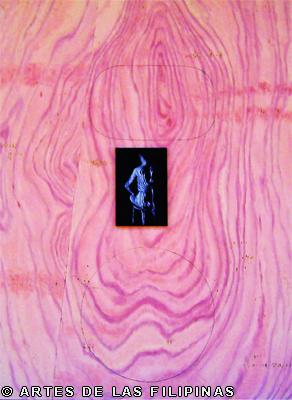
On Line Order (2008)
Tell me some things about your personal background.
My father is from Taal, Batangas and my mother is from Sara, Iloilo. I studied my elementary at the Colegio del Sagrado Corazon de Jesus in Iloilo City and my high school at St. Clement’s College. My grandfather on my father side was a woodcarver and my Tatay (father) was a civil engineer. On my mother’s side, my uncles and aunts are professionals and my Nanay (mother) is a pharmacist and a guidance counselor. I owe them my education and outlook in life.
Why did you spend your growing years in Iloilo and not in Batangas?
I spent my summer vacations in Taal, Batangas. Both my parents worked in Iloilo.
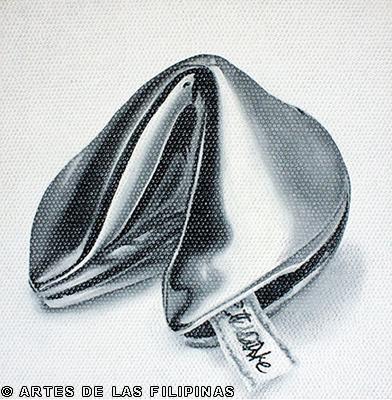
Not A Word That Has But The Same Meaning (2008)
Tracing your painting career in 1985, how has being an artist helped you in your life?
Getting away with ideas and works that are done with the freedom of a spoiled brat.
What about the physical things? Did your income as an artist enable you to send your children to school or put food in the table?
Yes, but I still need to see how it goes in the long run.
How do you react to people who have not heard or seen your works or would even say, “Who is Cris Villanueva?”
Most people have heard of Cris Villanueva, the actor and TV personality but if they have not heard of Cris Villanueva Jr. then it may mean that they have not seen the bubble-wrap paintings which to me is not so important because people always see paintings and objects bubble-wrapped.

My Red, My Blue, My Yellow, My Black (2008)
Have you had your experience of being wrongly rumored?
Not yet! (laughs)
I noticed that you don’t sign your canvas.
Sometimes, I find the signature unnecessary and distracting. People would later identify my styles and they already recognize my bubble-wrap signature. Actually, if one will look closer at the lower left portion of the bubble-wrap, I insert small letters on each alternating bubbles and spell my name and the date I completed the work.
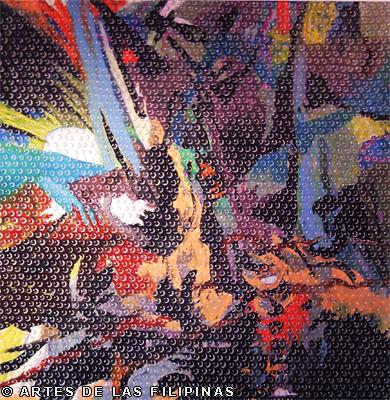
Pow-Bam-Sock (2008)
When you are in the process of working, who exactly is the viewer you have in mind?
The future artists and the audience viewing my work.
How can viewers discern if a work is by Cris Villanueva?
The bubble, the look and the concept and my eclectic style. I draw inspiration from faults and imperfections.
How did your idea of layering a bubble wrap come about?
I accidentally imprinted bubbles from a plastic wrap on one painting. When I finally brought thirteen works for a show in San Francisco, I unpacked the crate and saw all paintings looked interesting when wrapped. Walking along Mission Street in San Francisco, I spotted a huge billboard which had an empty white background and a logo of Sealed Air Corporation, the manufacturer of the bubble-wrap and a caption that “the world has changed since the invention of the bubble-wrap” or something similar to that. I went home to the Philippines and on the plane I decided to paint just like that.

Sack My Duck (2008)
Your style is obviously labor intensive. Do you use a grid?
Yes and No. I don’t use the grid before but to have assurance that I reproduced a photo well, I have sometimes use one but depending on the style of work I do since I have several works and some works do not rely on using a grid. There are also the factors of age and failing eyesight that I have to take into consideration.
How long does it take you to finish a work?
It depends on the style. Photorealistic paintings take around three days to finish and another two more days of bubble-wrap hand painted bubbles.
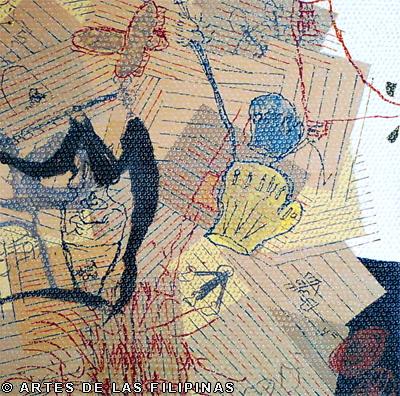
Tattersall (2009)
What are the factors that you consider when pricing your works?
A standard per inch price has been set since I exhibit in several galleries here and abroad to make it easier to price and have a consistent value for my works. This will also rate how the prices have fared through the years and re-assure collectors and galleries of the well evaluated prices.
I noticed artists such as you paint while the radio is on. What music do you feel good while working?
Miles Davis, Bob Dylan, the late great bass player Dondi Ledesma, a classmate of mine in high school.
What to you is a comfortable time to work?
I start work at 7:30 a.m. then I have lunch at 12 noon. I watch DVD movies after I had lunch then I go back to work at around 4 p.m.
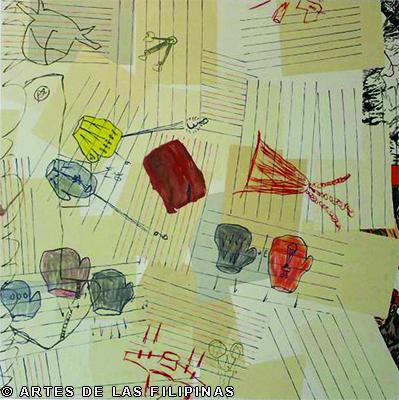
Tattersall (2009)
Do you have an idea of the profile of collectors who buy your works?
Dr. Joven Cuanang, Charlie Cojuangco, Sonny Angara, Dr. Ayco, Vita Sarenas, Valentine Willie and some Singaporean collectors like Keng Hock and Kim Khor Huat and several others.
Is there any other collector you wished who would own your paintings?
(laughs) Charles and Maurice Saatchi and maybe the nuns of the Pink Sisters in Baguio.
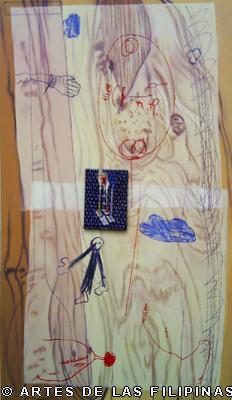
Why You Have To Be Stupid and Viscious (2009)
In the last five years you’ve been painting full-time, how many works have you produced and how many solo exhibits have you had since 2006?
I’ve lost count with my works but my solo exhibits are more or less twice a year.
What has been the most memorable one you’ve had?
The first show at Oar House in Malate because it paved the way for more shows.
How do you document your works?
I take pictures of the works and file them in a CD or DVD-ROM. Some of my large paintings are photographed everyday to document each portion and to have a record of how I painted the bubble-wrap over the under-painting.
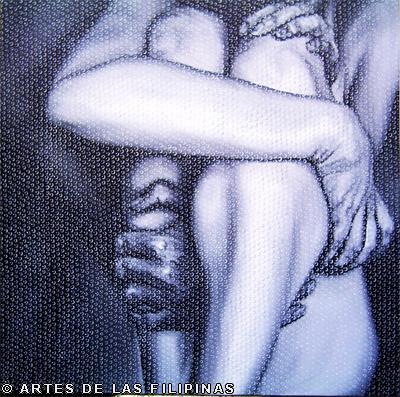
Sealing Comfort 2 (2009)
Who handles the business side of your profession?
My wife, Jenny.
Why do you think that the artists’ wives are the ones doing the business side of their husband’s profession?
This set-up was not planned. It just comes out naturally for the spouse to be involved because of the relationship she has with the artist. Wives are also natural custodians of their husband’s works.
Who are some of the most interesting people in the arts you’ve met and talked to?
The outsider artists who never had any formal schooling and those people who are not aware that they are very good artists.
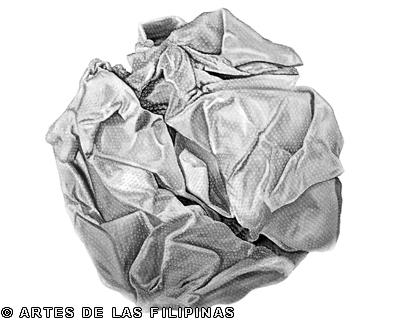
Self-Defense (2010)
In the art scene of today, what is it that you enjoy the most?
Painting more than the exhibition openings. Also, the spirit of discovery.
What has been the best compliment said about you or your work?
“The work (“Something’s Missing But Something Is Found”) is an amalgam of discomfiting dreamscape, eccentric puzzle, resolute conceptualism, a formalist trompe l’oiel; in brief a witty hybrid of visual conundrum and suspended disbelief. Beside this visual tour de force, even the most scintillating colors and radical compositions pale into significance.” --- Cid Reyes : “ Philip Morris Philippine Art Awards – A Decade of Inspired Creativity.”
And what have you been criticized of?
Having several styles of work which I intentionally did to convey the idea that you don’t have to have a specific style or an artist’s signature. Whatever I do, I will always have my own and unique idea and that my style will always change.

Saling-Pusa (2010)
What do your parents and family have to say about your works?
They go to my shows and sometimes they like my works but seldom do they fully comprehend my work. My wife and my sons learn and appreciate my works but my two sons who know how to paint paint differently from what I do.
What can you say is your clear talent in painting?
Discovering something new continuously and not worrying until when it would last.
Do you think that your works will hold a place in the history of Philippe art?
Whether it does or does not, I am happy with what I have already done. What is important is that generations from now, I hope that people will enjoy viewing my works whether they have been sold or have remained in my family's collection.
Recent Articles
 FEDERICO SIEVERT'S PORTRAITS OF HUMANISM
FEDERICO SIEVERT'S PORTRAITS OF HUMANISMJUNE 2024 – Federico Sievert was known for his art steeped in social commentary. This concern runs through a body of work that depicts with dignity the burdens of society to...
.png) FILIPINO ART COLLECTOR: ALEXANDER S. NARCISO
FILIPINO ART COLLECTOR: ALEXANDER S. NARCISOMarch 2024 - Alexander Narciso is a Philosophy graduate from the Ateneo de Manila University, a master’s degree holder in Industry Economics from the Center for Research and...
 An Exhibition of the Design Legacy of Salvacion Lim Higgins
An Exhibition of the Design Legacy of Salvacion Lim HigginsSeptember 2022 – The fashion exhibition of Salvacion Lim Higgins hogged the headline once again when a part of her body of work was presented to the general public. The display...
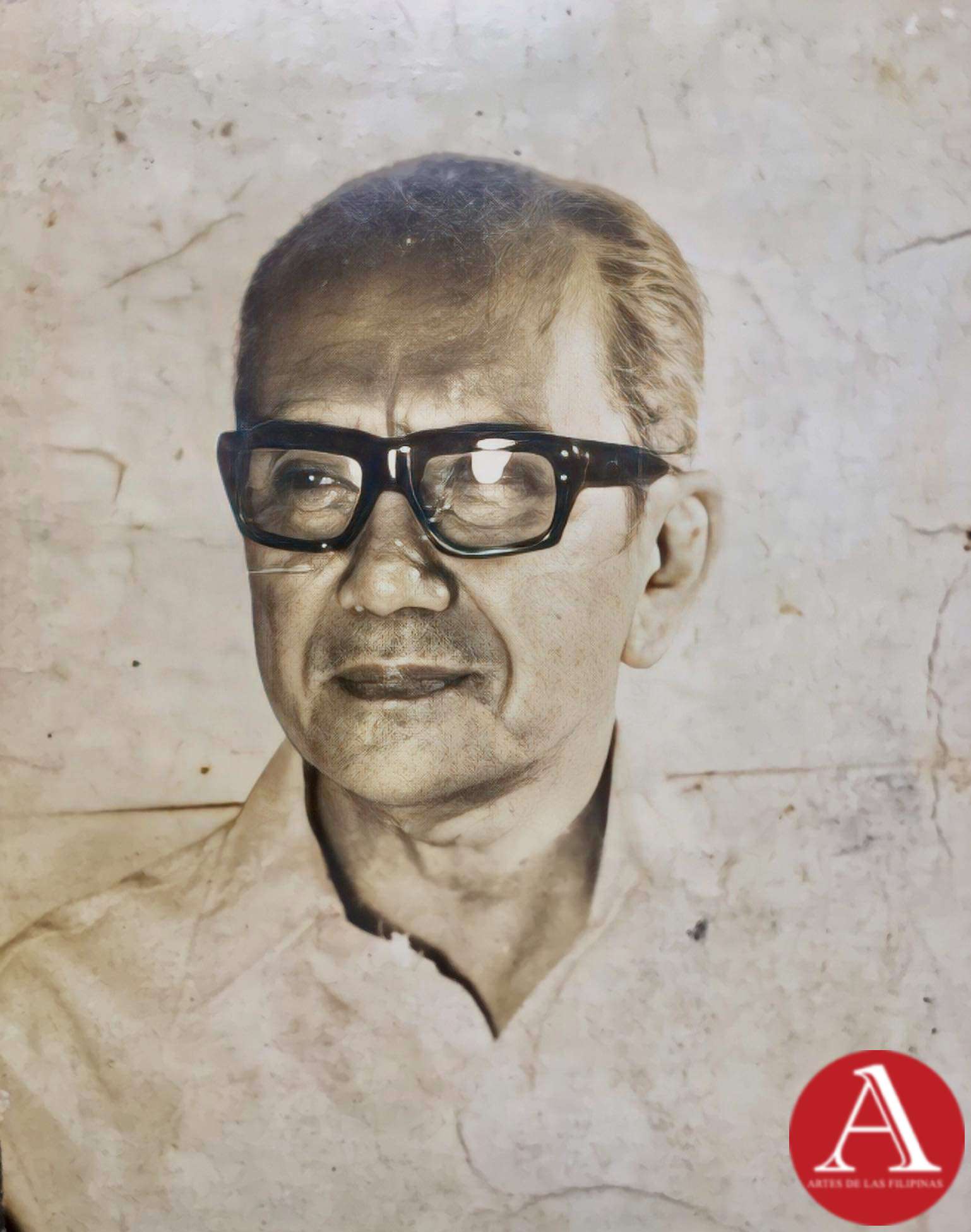 Jose Zabala Santos A Komiks Writer and Illustrator of All Time
Jose Zabala Santos A Komiks Writer and Illustrator of All TimeOne of the emblematic komiks writers in the Philippines, Jose Zabala Santos contributed to the success of the Golden Age of Philippine Komiks alongside his friends...
 Patis Tesoro's Busisi Textile Exhibition
Patis Tesoro's Busisi Textile Exhibition
The Philippine Art Book (First of Two Volumes) - Book Release April 2022 -- Artes de las Filipinas welcomed the year 2022 with its latest publication, The Philippine Art Book, a two-volume sourcebook of Filipino artists. The...
 Lamberto R. Hechanova: Lost and Found
Lamberto R. Hechanova: Lost and FoundJune 2018-- A flurry of renewed interest was directed towards the works of Lamberto Hechanova who was reputed as an incubator of modernist painting and sculpture in the 1960s. His...
 European Artists at the Pere Lachaise Cemetery
European Artists at the Pere Lachaise CemeteryApril-May 2018--The Pere Lachaise Cemetery in the 20th arrondissement in Paris, France was opened on May 21, 1804 and was named after Père François de la Chaise (1624...
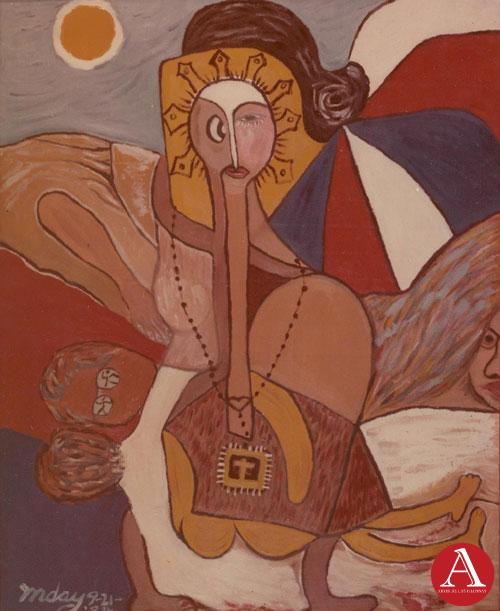 Inday Cadapan: The Modern Inday
Inday Cadapan: The Modern IndayOctober-November-December 2017--In 1979, Inday Cadapan was forty years old when she set out to find a visual structure that would allow her to voice out her opinion against poverty...
 Dex Fernandez As He Likes It
Dex Fernandez As He Likes ItAugust-September 2017 -- Dex Fernandez began his art career in 2007, painting a repertoire of phantasmagoric images inhabited by angry mountains, robots with a diminutive sidekick,...




